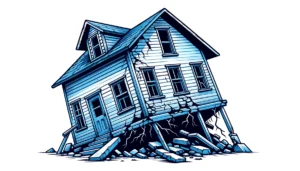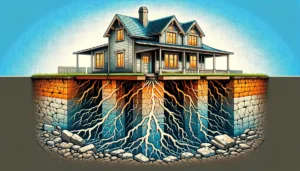What Is a Pier and Beam Foundation? The Pros, Cons, and Repair Guide for Homeowners
In this article, we’ll cover:
ToggleHey there, homeowner! Let’s talk about your home’s foundation. I know, I know, it’s not the most exciting topic. But trust me, it’s important stuff. Imagine waking up one morning to find your floor has turned into a roller coaster ride. Not fun, right? That’s where understanding your type of foundation comes in handy. In this post, we’ll dive into the world of pier and beam foundations. We’ll cover what they are, their pros and cons, and how to keep them in tip-top shape. So, grab a cup of coffee and let’s get started!
![]()
What Is a Pier and Beam Foundation?
A pier and beam foundation, also known as post and beam, is a type of foundation that raises your home off the ground. It consists of three main parts:
- Piers: These are the vertical supports that hold up your home. They can be made of concrete, brick, or even treated wood.
- Beams: These are the horizontal supports that extend from one pier to another. They’re typically made of wood or steel.
- Joists: These are the smaller beams that run perpendicular to the main beams and support your flooring.
Pier and beam foundations create a crawl space under your home, which can be anywhere from a few inches to several feet high. This is different from a concrete slab foundation, where your home sits directly on a flat slab of concrete.
Pros and Cons of Pier and Beam Foundations
Like any home foundation type, pier and beam foundations have their advantages and disadvantages. Let’s take a look at some of the pier and beam foundation pros and cons.
Advantages of Pier and Beam Foundations
- Access to plumbing and electrical: With a crawl space, it’s easier to access your home’s plumbing and electrical systems for repairs or upgrades.
- Improved ventilation: The crawl space allows air to circulate under your home, which can help prevent moisture buildup and mold growth.
- Protection against flooding: Since your home is raised off the ground, it’s less likely to be damaged by flooding.
- Easier to level and repair: If your foundation starts to settle or shift, it’s often easier and less expensive to repair a pier and beam foundation than a slab foundation.
Disadvantages of Pier and Beam Foundations
- Higher construction costs: Pier and beam foundations are generally more expensive than slab foundations because they require more materials and labor to build.
- Potential for moisture and pest issues: If your crawl space isn’t properly ventilated or sealed, it can become a breeding ground for mold, mildew, and pests like termites and rodents.
- Reduced energy efficiency: The air space under your home can make it harder to heat and cool efficiently, leading to higher energy bills.
- More maintenance required: Pier and beam foundations require regular inspections and maintenance to prevent foundation issues and keep your home in good shape.
Pier and Beam Foundation vs Slab Foundation
Now that we’ve covered the basics of pier and beam foundations, let’s compare them to the other common type of foundation: the slab foundation.
A slab foundation is a flat concrete pad that your home sits directly on. It’s typically reinforced with steel rebar and concrete beams around the perimeter of the house.
Here are some of the slab foundation pros and cons:
| Pros | Cons |
|---|---|
| Less expensive to build | Can crack or shift in unstable soil |
| Faster construction time | Difficult and costly to repair |
| More energy efficient | Prone to flooding in low-lying areas |
| Fewer pest and moisture issues | Limited access to plumbing and electrical |
So, which foundation is best for your home? It depends on factors like your budget, location, soil conditions, and personal preferences. In general, pier and beam foundations are a good choice for homes in areas prone to flooding or with expansive clay soils. Slab foundations are more common in newer homes and drier climates like the Southwest.
![]()
Common Issues with Pier and Beam Foundations
Even the best foundation can develop problems over time. Here are some of the most common issues with pier and beam foundations:
- Sagging or uneven floors: If your floor joists or beams are damaged or improperly spaced, your floors may start to sag or feel bouncy.
- Moisture and humidity problems: Poor ventilation or drainage can lead to high humidity levels and moisture damage in your crawl space.
- Pest infestations: Termites, carpenter ants, and other wood-boring insects can damage the wooden components of your foundation.
- Structural damage: Shifting soil, tree roots, or poor construction can cause your piers or beams to crack, rot, or shift out of place.
If you notice any of these foundation problems, it’s important to address them promptly to prevent further damage to your home.
How to Repair a Pier and Beam Foundation
If you suspect your pier and beam foundation may need repairs, here are some signs to look for:
- Cracks in your walls or ceilings
- Doors or windows that stick or won’t close properly
- Gaps between your floor and baseboards
- Musty odors or visible mold in your crawl space
If you notice any of these red flags, it’s time to call in a professional foundation repair company like Portman Foundation Repair. We specialize in pier and beam foundation repair and serve homeowners throughout the DFW Metroplex.
The cost of pier and beam foundation repair can vary depending on the extent of the damage and the repair methods used. On average, homeowners can expect to pay between $5,000 and $15,000 for pier and beam foundation repair. However, catching problems early can help minimize repair costs and prevent more serious foundation damage.
Maintaining Your Pier and Beam Foundation
The key to avoiding costly foundation repair needs is regular maintenance. Here are some tips for keeping your pier and beam foundation in good condition:
- Inspect your crawl space regularly: At least once a year, crawl under your home and check for signs of moisture, pest activity, or structural damage.
- Control moisture levels: Use a dehumidifier or vapor barrier to keep humidity levels low in your crawl space. Make sure your gutters and downspouts direct water away from the foundation.
- Prevent pest infestations: Seal any cracks or openings in your foundation to keep pests out. Consider having a professional pest control company treat your home regularly.
- Maintain proper drainage: Make sure the soil around your foundation slopes away from your home to prevent water from pooling near the piers.
By following these maintenance tips, you can help extend the life of your pier and beam foundation and avoid costly repairs down the road.
![]()
Is a Pier and Beam Foundation Right for Your Home?
When choosing a foundation type for your new home or evaluating an existing pier and beam home, there are several factors to consider:
- Climate and soil conditions: Pier and beam foundations perform well in areas with high water tables or expansive soils that can cause slab foundations to crack.
- Accessibility: If you need easy access to your home’s plumbing, electrical, or HVAC systems, a pier and beam foundation may be a good choice.
- Resale value: While pier and beam homes can be harder to sell in some markets, they may be more desirable in areas where pier and beam construction is common or prone to flooding.
Ultimately, the best foundation for your home will depend on your specific needs, budget, and location. If you’re unsure whether a pier and beam foundation is right for you, consult with a local foundation repair company or structural engineer for expert advice.
![]()
Need Professional Foundation Repair Services?
At Portman Foundation Repair, we understand how stressful foundation issues can be for homeowners. That’s why we offer comprehensive pier and beam foundation repair services to help you protect your biggest investment.
Our team of experienced professionals uses the latest tools and techniques to diagnose and repair all types of pier and beam foundation problems. From joist and perimeter beam repairs to drainage improvements and moisture control, we’ve got you covered.
If you’re a homeowner in the DFW Metroplex area and need pier and beam foundation repair, give us a call at (469) 957-7343. We offer free inspections and estimates, and our work is backed by a lifetime transferable warranty.
Don’t let foundation problems keep you up at night. Trust the experts at Portman Foundation Repair to give you peace of mind and a solid foundation for your home.
Don’t Let Foundation Problems Bring You Down: Trust the Pier and Beam Experts
Foundation issues can be a homeowner’s worst nightmare, causing stress, anxiety, and potentially costly repairs. Whether you have a pier and beam foundation or are considering one for your new home, it’s crucial to understand the pros, cons, and maintenance requirements of this foundation type.
Throughout this post, we’ve explored the ins and outs of pier and beam foundations, from their basic structure and benefits to common problems and repair methods. We’ve seen that while pier and beam foundations offer advantages like improved access and ventilation, they also come with challenges like moisture control and pest prevention.
The key takeaway is that regular maintenance and prompt attention to any foundation problems are essential for protecting your home and avoiding costly repairs down the road. By following the tips we’ve outlined, like inspecting your crawl space regularly, controlling moisture levels, and maintaining proper drainage, you can help extend the life of your pier and beam foundation.
If you do encounter foundation issues, don’t panic! Foundation repair companies like Portman Foundation Repair are here to help. Our experienced professionals can diagnose and repair all types of pier and beam foundation problems, from sagging floors to structural damage. We use state-of-the-art techniques to reinforce your foundation and give you peace of mind.
So, whether you’re a current pier and beam homeowner or considering this foundation type for your new build, remember that knowledge is power. By understanding the unique characteristics and requirements of pier and beam foundations, you can make informed decisions and keep your home on solid ground for years to come.
Don’t let foundation problems bring you down. Trust the experts at Portman Foundation Repair to provide the support you need, just like a strong and stable pier and beam foundation. Contact us today for a free inspection and estimate, and let us help you build a solid foundation for your home and your peace of mind.



